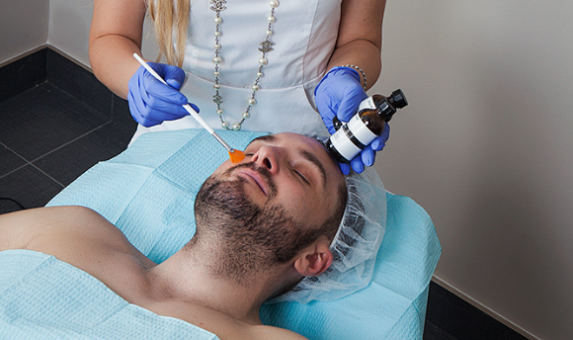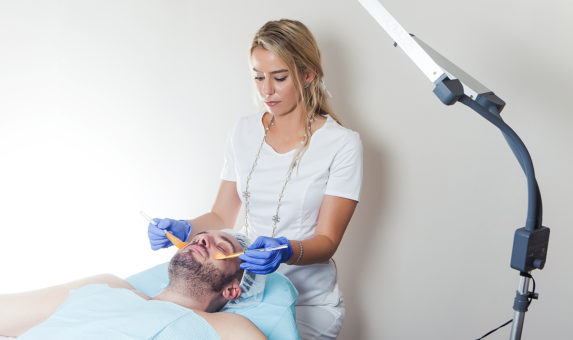Chemical peels have been a trusted solution for achieving radiant skin. Here at Karmina Beauty Clinic, located in Forest Hills, Queens, NYC, under Karmina Lacku’s guidance, we understand this treatment’s power. If you’re looking for a professional chemical peel in NYC, our clinic offers a non-surgical approach to address various concerns, regardless of skin type or tone.
What is a Chemical Peel Treatment?
Chemical peel treatments are designed to enhance the appearance of the skin, particularly on the face, neck, and hands. This treatment involves the application of a specialized chemical solution that causes the outer layer of skin to exfoliate and eventually peel off. As the old, damaged skin sheds, it reveals fresh, rejuvenated skin underneath that is typically smoother, more even-toned, and radiant.
Chemical peels can address various skin concerns such as fine lines, wrinkles, acne scars, pigmentation issues, and overall skin texture. The treatment has gained immense popularity in recent years due to its effectiveness and the noticeable improvements it provides.
At Karmina Beauty Clinic, a leading provider of professional chemical peel treatments in NYC, our expert team tailors each chemical peel treatment to your specific skin type and concerns, ensuring optimal results and a revitalized complexion. Discover why chemical peels have become a favored choice for skin rejuvenation and learn more about how this transformative treatment can benefit you.
THE BENEFITS OF CHEMICAL PEEL TREATMENT
- Reducing fine lines and wrinkles
- Minimizing the appearance of pores
- Boosting collagen production for plumper, younger-looking skin
- Addressing mild acne scarring
- Fading hyperpigmentation, sun damage, and uneven skin tone
- Improving the texture of rough, bumpy skin
Chemical Peel Facial


Types of Chemical Peel
Chemical peels come in various depths, each targeting specific skin concerns:
- Light Peels (AHA Peels): Ideal for mild concerns like dryness, uneven texture, and sun damage. These peels use alpha hydroxy acids (AHAs) like glycolic or lactic acid.
- Medium Peels (TCA Peels): Address deeper concerns like wrinkles, acne scars, and uneven pigmentation. These peels utilize trichloroacetic acid (TCA) to reach the mid-layers of the skin.
- Deep Peels (Phenol Peels): Reserved for severe sun damage and deeper wrinkles. Deep peels use phenol and require extensive downtime for recovery.
How Does a Chemical Peel Treatment Work?
A chemical peel is a treatment that utilizes a carefully chosen chemical solution to exfoliate the skin. The solution is applied to the cleansed face, and depending on the strength of the peel, you might experience a tingling or burning sensation that typically fades quickly. This controlled injury triggers the skin’s natural healing process. As the outer layers are dissolved, new skin cell growth is stimulated beneath the surface. This new skin is usually smoother, with a more even tone and texture, and can address various concerns like wrinkles, acne scars, and sun damage. Chemical peels come in different depths, offering a range of benefits depending on your specific needs.
Considering a Chemical Peel in NYC? This treatment has become increasingly popular for its ability to rejuvenate the skin. If you’re looking to achieve a brighter, more youthful appearance, a Chemical Peel might be the perfect solution for you.
Chemical Peel Consultation Process
At Karmina Beauty Clinic in Forest hills, Queens, NYC, we understand that every patient’s skin is unique, and so should their chemical peel treatment. That’s why we prioritize a personalized approach through a thorough consultation process. During this consultation, we’ll take the time to discuss your desired outcomes and explore your medical history in detail. This allows us to identify any potential concerns or contraindications for chemical peels. We’ll then carefully assess your skin’s current condition, taking note of factors like texture, tone, sun damage, and the presence of wrinkles or scars. This comprehensive evaluation helps us determine the most suitable type and strength of chemical peel to address your specific needs and achieve your aesthetic goals. Feel free to ask any questions you may have about the procedure, aftercare instructions, or potential side effects. We want you to feel completely comfortable and informed before chemical peel treatment.
Chemical Peel Aftercare Instructions
After your chemical peel treatment in NYC, following a dedicated aftercare routine is essential to optimize your results and minimize potential side effects. Our experienced staff at Karmina Beauty Clinic will provide you with detailed instructions tailored to your specific peel and skin’s response. These instructions will typically focus on four key areas:
- Gentle Cleansing: For the first few days following your peel, your skin will be especially delicate. To avoid irritation, it’s crucial to cleanse your face with lukewarm water only, patting it dry instead of rubbing. You can gradually introduce a gentle, fragrance-free cleanser after a few days, as directed by your clinician.
- Diligent Moisturizing: Chemical peels remove the outer layers of skin, which can leave your skin feeling dry and tight. Consistent and diligent moisturizing is vital to soothe irritation, prevent excessive flaking, and promote healthy healing. We may recommend a specific type of moisturizer formulated for post-peel care, which will help replenish moisture and support the skin’s natural barrier function.
- Sun Protection with SPF 30 or Higher (Absolutely Essential): Sun exposure is the enemy of freshly peeled skin. Following a chemical peel, your skin is significantly more susceptible to sun damage, which can lead to hyperpigmentation and hinder the treatment’s effectiveness. For several weeks after your peel, it’s absolutely essential to wear sunscreen with an SPF of 30 or higher every single day, even on cloudy days. Reapply sunscreen liberally throughout the day, especially if you’ll be spending time outdoors. In addition to sunscreen, consider wearing protective hats and seeking shade whenever possible.
- Avoiding Picking or Scratching: The peeling process can be tempting to tamper with, but it’s crucial to resist the urge to pick or scratch at the treated area. Picking can not only prolong healing but also increase the risk of scarring and infection. Allow the skin to shed naturally, and if itching occurs, consult your clinician for recommendations on how to soothe the irritation.

Chemical Peel FAQS
What is a chemical peel NYC?
A chemical peel is a cosmetic technique that smooths and improves the texture of your skin. During the chemical peel, facial skin is treated, and it can improve the appearance of scarring. This procedure intends to remove the dead layer of your skin.
Which chemical peel is best for my skin?
Our professional will evaluate your skin to find out which chemical peel will be best for you. An AHA (Alpha Hydroxy Acid) peel is good for mild skin discoloration, glycolic acid for rough skin, TCA (Trichloroacetic Acid) peel for improving fine lines, age spots, freckles, and more.
Do chemical peels hurt?
Medium and light chemical peels might cause minor discomfort, ranging from mild to moderate. It depends on the tolerance level of the individual. During the peel, many individuals may also feel a burning sensation that might last for five to ten minutes.
How will my skin look after a chemical peel treatment?
After the chemical peel procedure, you may observe some irritation, mild swelling, and dryness for the first few days. For the next two to three days, your skin may peel or appear flaky, and imperfections or discolorations may temporarily be more visible. Next three to four days, you may notice your skin is breaking out, looking tan, or somewhat darker compared to earlier.
Who is not suitable for a chemical peel?
You may not be a suitable candidate for a chemical peel, if you have a history of abnormal scarring of skin, naturally dark skin tone or complexion, had some acne treatments the previous year, your scars can get extra pigmentation, or some serious skin conditions or medicines that make your skin extremely sensitive.
Can I apply makeup after my treatment?
You should avoid cosmetics for a week or 10 days after you have a chemical peel treatment. Your skin will show excellent results when it will have extra time to breathe and heal. Makeup covers the upper layer of your skin and block the pores.
Ready to Reveal Your Radiant Skin with Chemical Peel in NYC?
Chemical peel in NYC can be a transformative treatment for achieving a smoother, more youthful complexion. Schedule a consultation with Karmina Beauty Clinic in forest hills, Queens, NYC today to discuss if a chemical peel is right for you and embark on your journey to luminous skin.
